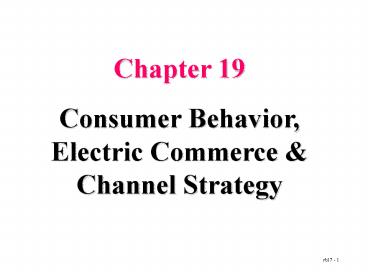Consumer Behavior, Electric Commerce - PowerPoint PPT Presentation
1 / 15
Title: Consumer Behavior, Electric Commerce
1
Chapter 19 Consumer Behavior, Electric Commerce
Channel Strategy
2
Store Affect and Cognition
1. Store Image the set of meanings consumers
associate with a particular store
Dimensions include Merchandise Service Physi
cal Facilities Clientele Convenience Promotion
Atmosphere Price
3
Store Affect and Cognition (continued)
2. Store Atmosphere emotional states that
consumers experience in a store, but may not be
fully conscious of while shopping
Emotional states include
Pleasure feels good, joyful, happy, or
satisfied Arousal feels excited, stimulated,
alert, or active in the store Dominance feels
in control of or free to act in the store
4
Store-Related Behavior
1. Store Contact - consumer locating, traveling
to, and entering a store
Examples of reinforcing tactics and positive
attributes
- Store visibility and location
- Yellow pages maps and location instructions
- Special Events
- Style shows in department stores
- Carnivals in parking lots
- Book signings
5
Store-Related Behavior (continued)
2. Store Loyalty - degree to which a consumer
consistently patronizes the same store relative
to competitive outlets
Examples of reinforcing tactics and positive
attributes
- In-store unadvertised specials (Fixed or Variable
ratio) - Fast checkout
- A pleasant and arousing store atmosphere
- High quality merchandise at competitive prices
6
Store Environment
1. In-store stimuli
- Signs and price information
- Price influences sales more than sign
type - Regular prices, a price sign will not
increase sales Sale prices, a price sign will
increase sales - Benefit signs increase sales at
both regular and sale prices, Greater rate when
the item is on sale - A benefit sign is more
effective than a price-only
7
Store Environment (continued)
1. In-Store Stimuli (continued)
- Shelf space and displays
Special display gt Expanded shelf space gt
Normal display
- Music
Slow tempo more sales
- Scent
- Product scents leather, perfume, chocolate,
coffee, flowers - Ambient scents neutral
pleasant (florals, spices, woods, citrus, mints)
8
Store Environment (continued)
1. In-store Stimuli (continued)
- Color
- Warm colors (red yellow) store windows,
entrances, impulse purchases - Cool colors
(blue green) customer deliberation areas
2. Store Location 3. Store Layout
9
Grid Store Layout
Frozen goods
Receiving and Storage
Bread
Paper products
Condiments
Fruits
Books and magazines
Checkouts
Vegetables
Customer services
10
Free-form Store Layout
Storage, receiving, marking
Dressing Rooms
Underwear
Access-ories
Checkout counter
Tops
Jeans/Casual Wear/Stockings
Skirts and dresses
Tops
Pants
11
Grid vs. Free-Form Layouts
Advantages
Disadvantages
Grid
Grid
Low cost Customer
familiarity Merchandise exposure Ease of
cleaning Simplified security Possibility of
self-service
Plain and uninteresting
Limited browsing Stimulates rushes shopping
Limited creativity in decor
Free-form
Free-form
Allows for browsing Increased impulse purchases
Visual appeal Flexibility
Loitering encouraged Possible confusion
Waste of floor space Difficulty of
cleaning Cost
12
Nonstore Purchasing Modes
Distribution Shares
- 1996 2001
- Catalog and Direct Mail 77.9 55.7
- Vending Machine Purchases 11.1 11.9
- Television Home Shopping 2.6 2.8
- Direct Sales Purchases 8.3 11.9
- Electronic Exchanges 0.1 17.7
13
Evaluation of Electronic Commerce
Advantages
Disadvantages
Product Increased selection Uncertainty about
quality Increased availability Inability to
experience before purchase
Promotion Increased information Information
overload Increased information from Time and
effort costs to access independent
agencies information
14
Evaluation of Electronic Commerce
Advantages
Disadvantages
15
Channel Design Criteria
Commodity
Characteristics of Intermediaries
Conditions
Consumers
Control
Competition
Competence
Costs
Coverage































